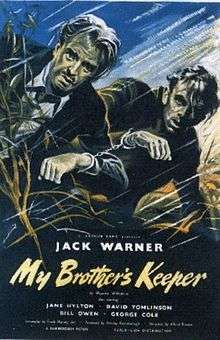My Brother's Keeper (1948 film)
| My Brother's Keeper | |
|---|---|
 UK release poster | |
| Directed by | Alfred Roome |
| Produced by | Sydney Box |
| Written by | Frank Harvey |
| Starring |
Jack Warner George Cole |
| Music by | Clifton Parker |
| Cinematography | Gordon Lang |
| Edited by | Esmond Seal |
Production company | |
Release dates | 9 August 1948 |
Running time | 96 min. |
| Country | United Kingdom |
| Language | English |
| Budget | £113,600[1] |
| Box office | £93,600 (by Dec 1949)[1] |
My Brother's Keeper is a 1948 British crime film in the form of a convicts-on-the-run chase thriller, directed by Alfred Roome for Gainsborough Pictures. It was the first of only two films directed by Roome (the other being the following year's comedy It's Not Cricket) during a long career as a film editor. The film stars Jack Warner and George Cole and was produced by Sydney Box.
Plot
Handcuffed together, George Martin (Jack Warner) and Willie Stannard (George Cole) are two newly convicted criminals being transported to prison. Martin is a hardened, cynical career criminal, while Stannard is a naïve, rather dull-witted youth who has never previously been in trouble with the law, maintains his innocence of the rape for which he has been convicted and is terrified by the prospect of prison. During the journey the pair manage to escape. Martin steals an army officer's uniform and passes Stannard off as a deserter in his charge, being returned to face a military tribunal.
The escape location has been chosen by Martin for its proximity to a garage run by his mistress Nora Lawrence (Jane Hylton), who provides the pair with overnight shelter. The following day Martin and Stannard take refuge in a derelict isolated cottage. While trying to file their handcuffs apart they are surprised by a hunting man with a gun. A struggle ensues, during which Martin shoots and kills the man. Shortly thereafter they manage to separate the handcuffs and Martin abandons Stannard, going on the run alone while Stannard gives himself up and is promptly charged with murder.
Martin manages to contact his wife in London, asking if she can find a way to get money to him. She arranges to travel by taxi to the woods in which he is hiding. Just as she arrives, the police have tracked Martin down and have him cornered. Rather than give himself up, Martin makes a final doomed attempt to escape through a signed minefield, watched by police, reporters, his wife and mistress and a crowd of sensation-seeking gawkers.
Cast
- Jack Warner as George Martin
- Jane Hylton as Nora Lawrence
- David Tomlinson as Ronnie Waring
- Bill Owen as Syd Evans
- George Cole as Willie Stannard
- Yvonne Owen as Meg Waring
- Raymond Lovell as Bill Wainwright
- Brenda Bruce as Winnie Foreman
- Susan Shaw as Beryl
- Beatrice Varley as Jenny Martin
- Garry Marsh as Brewster
- Maurice Denham as Superintendent Trent
- Frederick Piper as Gordon
- Wilfrid Hyde-White as Harding
- John Boxer as Police Sergeant Bert Foreman
- Amy Veness as Mrs. Gully
- Fred Groves as Crown Hotel landlord
- Arthur Hambling as Edward Hodges
- Valentine Dyall as Inspector at Milton Wells
- George Merritt as Constable at Milton Wells
- Jack Raine as Chief Constable Col. Heatherly
- Ben Williams as Policeman at Nora's Garage
- Christopher Lee as Second Constable
Production
The film was originally known as Double Pursuit. It was produced by Sydney Box who had just taken over as head of production at Gainsborough Studios and was keen to develop new talent. The film was based on a story by journalist Maurice Wiltshire, his first for the movies; it was the first screenplay for Frank Harvey, first credit as full producer for Anthony Yarnborough, first film for Alfred Roome, first film for the editor and cinematographer, and first starring role for George Cole. It was shot in 45 days, nine ahead of schedule and £20,000 under budget. Several who worked on the film were rewarded with long term contracts at Gainsborough.[2]
Reception
My Brother's Keeper is a well-regarded film, with a reputation as a tight, tense and fast-moving thriller with Roome's previous editing experience being well utilised. The characterisation of the two main protagonists is praised for going deeper than the stereotypes of the tough, reckless criminal and the dim, hapless innocent. Via the 1950 film The Blue Lamp, and Dixon of Dock Green, the TV series developed from it which ran until the mid-1970s, Warner became forever engrained on the British consciousness as George "Evenin' all" Dixon, the avuncular upholder of law and order. My Brother's Keeper is often cited as an example of the dramatic range of which Warner was capable, before he became typecast. Cole's performance too is credited as one of the factors in his unusually smooth transition from child star to adult actor. The film's main weakness is cited as the interpolation of a pseudo-comic and largely irrelevant subplot involving a newspaper reporter trying to cover the story while on honeymoon in the area.
Box Office
The film recorded a loss of £9,400.[1]
Location filming
My Brother's Keeper's exterior location sequences were filmed in the Buckinghamshire/Oxfordshire border area, including scenes shot at the now abandoned Aston Rowant railway station.
See also
References
- 1 2 3 Andrew Spicer, Sydney Box Manchester Uni Press 2006 p 210
- ↑ Andrew Spicer, "The Apple of Mr. Rank’s Mercatorial Eye’: Managing Director of Gainsborough Pictures
External links
- My Brother's Keeper at the Internet Movie Database
- My Brother's Keeper at AllMovie
- My Brother's Keeper at the British Film Institute's Screenonline
- My Brother's Keeper at BritMovie
- Review of film at Variety